Financial Accounting Assignment: Concepts, Statements, and Analysis
VerifiedAdded on 2020/10/05
|21
|5682
|262
Homework Assignment
AI Summary
This financial accounting assignment provides a detailed exploration of fundamental accounting concepts and their practical application. It begins with an introduction to core principles such as debits and credits, the double-entry bookkeeping system, and the roles of the cash book, ledger, and trial balance. The assignment then delves into crucial adjustments like accruals and depreciation, and it explains the preparation and interpretation of key financial statements, including the profit and loss account, balance sheet, and cash flow statement. The document also covers essential topics such as bad debts, bank reconciliation, control accounts, and suspense accounts. The assignment includes practical exercises, such as preparing journal entries, ledgers, and a trial balance for J&J Ltd., as well as bank reconciliation for ABC Ltd. It also addresses the process of reconciling control accounts and clearing suspense accounts, culminating in the preparation of a conclusion and references for further study.
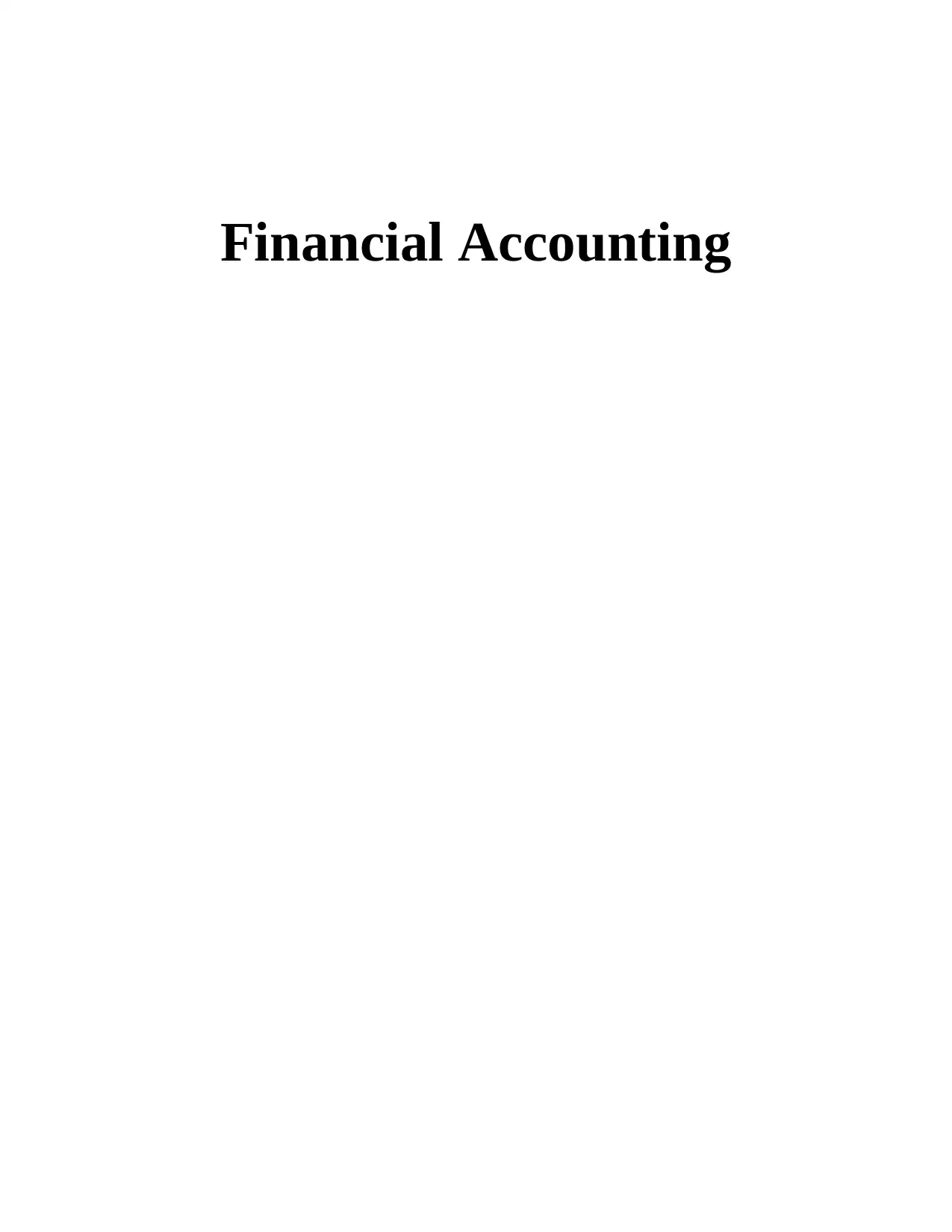
Financial Accounting
Paraphrase This Document
Need a fresh take? Get an instant paraphrase of this document with our AI Paraphraser
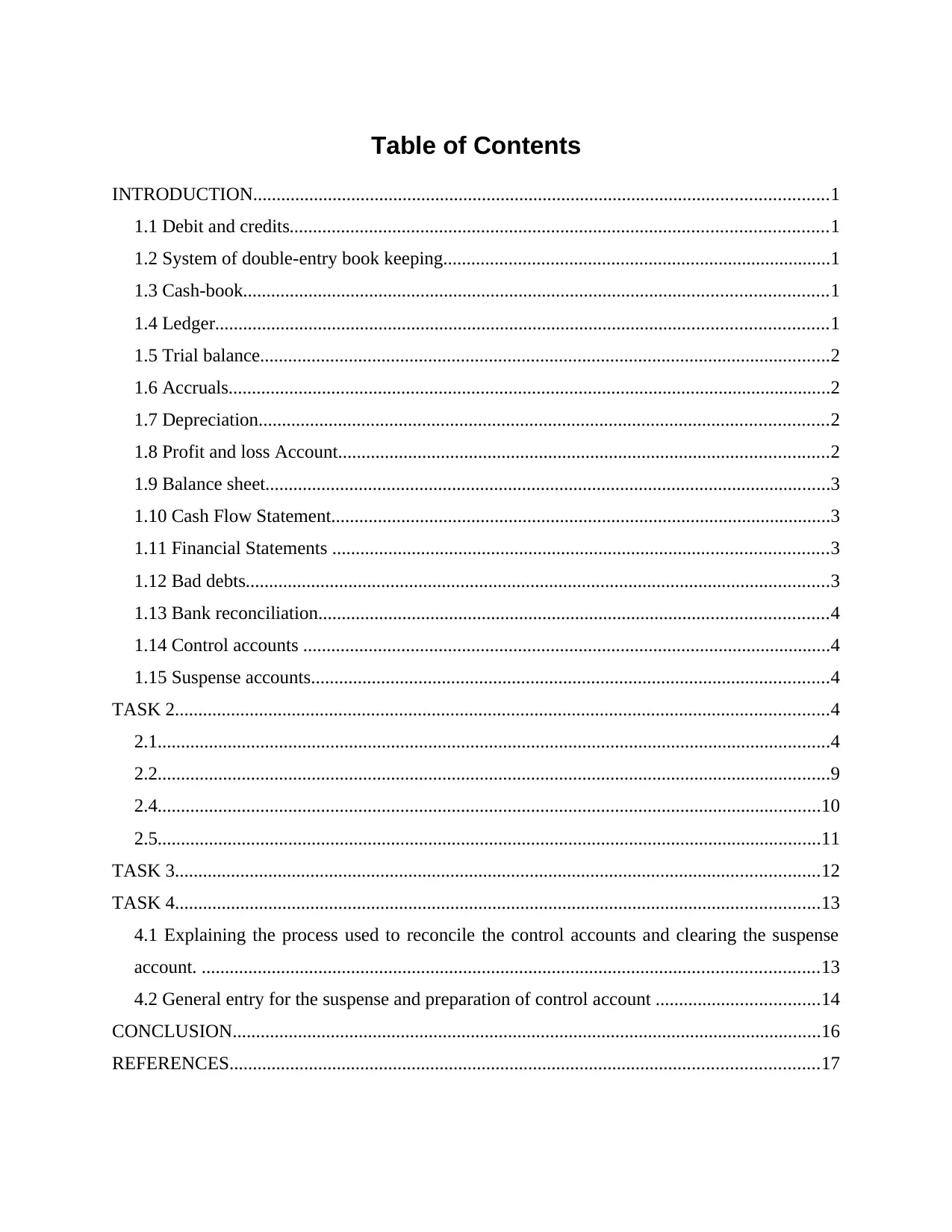
Table of Contents
INTRODUCTION...........................................................................................................................1
1.1 Debit and credits...................................................................................................................1
1.2 System of double-entry book keeping...................................................................................1
1.3 Cash-book.............................................................................................................................1
1.4 Ledger...................................................................................................................................1
1.5 Trial balance..........................................................................................................................2
1.6 Accruals.................................................................................................................................2
1.7 Depreciation..........................................................................................................................2
1.8 Profit and loss Account.........................................................................................................2
1.9 Balance sheet.........................................................................................................................3
1.10 Cash Flow Statement...........................................................................................................3
1.11 Financial Statements ..........................................................................................................3
1.12 Bad debts.............................................................................................................................3
1.13 Bank reconciliation.............................................................................................................4
1.14 Control accounts .................................................................................................................4
1.15 Suspense accounts...............................................................................................................4
TASK 2............................................................................................................................................4
2.1................................................................................................................................................4
2.2................................................................................................................................................9
2.4..............................................................................................................................................10
2.5..............................................................................................................................................11
TASK 3..........................................................................................................................................12
TASK 4..........................................................................................................................................13
4.1 Explaining the process used to reconcile the control accounts and clearing the suspense
account. ....................................................................................................................................13
4.2 General entry for the suspense and preparation of control account ...................................14
CONCLUSION..............................................................................................................................16
REFERENCES..............................................................................................................................17
INTRODUCTION...........................................................................................................................1
1.1 Debit and credits...................................................................................................................1
1.2 System of double-entry book keeping...................................................................................1
1.3 Cash-book.............................................................................................................................1
1.4 Ledger...................................................................................................................................1
1.5 Trial balance..........................................................................................................................2
1.6 Accruals.................................................................................................................................2
1.7 Depreciation..........................................................................................................................2
1.8 Profit and loss Account.........................................................................................................2
1.9 Balance sheet.........................................................................................................................3
1.10 Cash Flow Statement...........................................................................................................3
1.11 Financial Statements ..........................................................................................................3
1.12 Bad debts.............................................................................................................................3
1.13 Bank reconciliation.............................................................................................................4
1.14 Control accounts .................................................................................................................4
1.15 Suspense accounts...............................................................................................................4
TASK 2............................................................................................................................................4
2.1................................................................................................................................................4
2.2................................................................................................................................................9
2.4..............................................................................................................................................10
2.5..............................................................................................................................................11
TASK 3..........................................................................................................................................12
TASK 4..........................................................................................................................................13
4.1 Explaining the process used to reconcile the control accounts and clearing the suspense
account. ....................................................................................................................................13
4.2 General entry for the suspense and preparation of control account ...................................14
CONCLUSION..............................................................................................................................16
REFERENCES..............................................................................................................................17
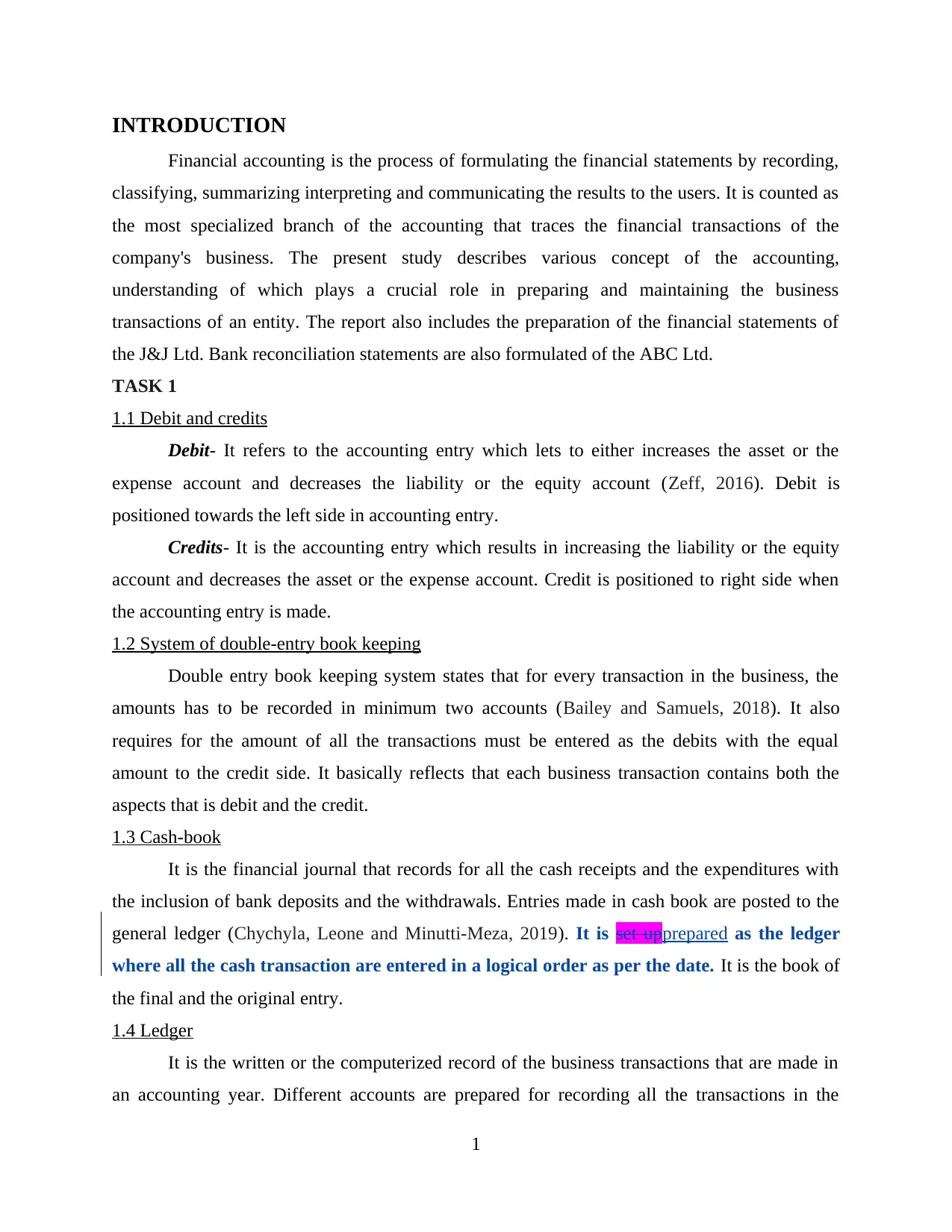
INTRODUCTION
Financial accounting is the process of formulating the financial statements by recording,
classifying, summarizing interpreting and communicating the results to the users. It is counted as
the most specialized branch of the accounting that traces the financial transactions of the
company's business. The present study describes various concept of the accounting,
understanding of which plays a crucial role in preparing and maintaining the business
transactions of an entity. The report also includes the preparation of the financial statements of
the J&J Ltd. Bank reconciliation statements are also formulated of the ABC Ltd.
TASK 1
1.1 Debit and credits
Debit- It refers to the accounting entry which lets to either increases the asset or the
expense account and decreases the liability or the equity account (Zeff, 2016). Debit is
positioned towards the left side in accounting entry.
Credits- It is the accounting entry which results in increasing the liability or the equity
account and decreases the asset or the expense account. Credit is positioned to right side when
the accounting entry is made.
1.2 System of double-entry book keeping
Double entry book keeping system states that for every transaction in the business, the
amounts has to be recorded in minimum two accounts (Bailey and Samuels, 2018). It also
requires for the amount of all the transactions must be entered as the debits with the equal
amount to the credit side. It basically reflects that each business transaction contains both the
aspects that is debit and the credit.
1.3 Cash-book
It is the financial journal that records for all the cash receipts and the expenditures with
the inclusion of bank deposits and the withdrawals. Entries made in cash book are posted to the
general ledger (Chychyla, Leone and Minutti-Meza, 2019). It is set upprepared as the ledger
where all the cash transaction are entered in a logical order as per the date. It is the book of
the final and the original entry.
1.4 Ledger
It is the written or the computerized record of the business transactions that are made in
an accounting year. Different accounts are prepared for recording all the transactions in the
1
Financial accounting is the process of formulating the financial statements by recording,
classifying, summarizing interpreting and communicating the results to the users. It is counted as
the most specialized branch of the accounting that traces the financial transactions of the
company's business. The present study describes various concept of the accounting,
understanding of which plays a crucial role in preparing and maintaining the business
transactions of an entity. The report also includes the preparation of the financial statements of
the J&J Ltd. Bank reconciliation statements are also formulated of the ABC Ltd.
TASK 1
1.1 Debit and credits
Debit- It refers to the accounting entry which lets to either increases the asset or the
expense account and decreases the liability or the equity account (Zeff, 2016). Debit is
positioned towards the left side in accounting entry.
Credits- It is the accounting entry which results in increasing the liability or the equity
account and decreases the asset or the expense account. Credit is positioned to right side when
the accounting entry is made.
1.2 System of double-entry book keeping
Double entry book keeping system states that for every transaction in the business, the
amounts has to be recorded in minimum two accounts (Bailey and Samuels, 2018). It also
requires for the amount of all the transactions must be entered as the debits with the equal
amount to the credit side. It basically reflects that each business transaction contains both the
aspects that is debit and the credit.
1.3 Cash-book
It is the financial journal that records for all the cash receipts and the expenditures with
the inclusion of bank deposits and the withdrawals. Entries made in cash book are posted to the
general ledger (Chychyla, Leone and Minutti-Meza, 2019). It is set upprepared as the ledger
where all the cash transaction are entered in a logical order as per the date. It is the book of
the final and the original entry.
1.4 Ledger
It is the written or the computerized record of the business transactions that are made in
an accounting year. Different accounts are prepared for recording all the transactions in the
1
⊘ This is a preview!⊘
Do you want full access?
Subscribe today to unlock all pages.

Trusted by 1+ million students worldwide
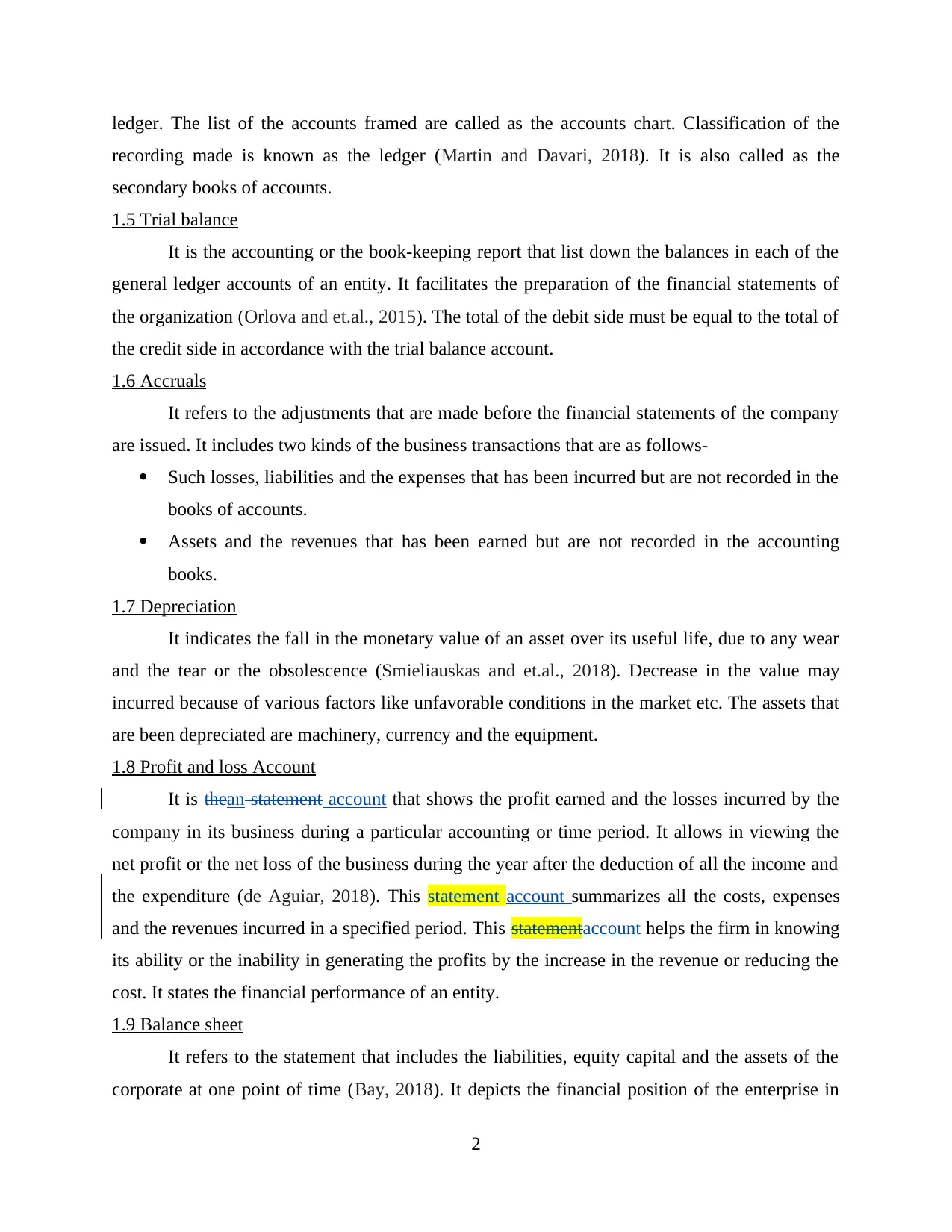
ledger. The list of the accounts framed are called as the accounts chart. Classification of the
recording made is known as the ledger (Martin and Davari, 2018). It is also called as the
secondary books of accounts.
1.5 Trial balance
It is the accounting or the book-keeping report that list down the balances in each of the
general ledger accounts of an entity. It facilitates the preparation of the financial statements of
the organization (Orlova and et.al., 2015). The total of the debit side must be equal to the total of
the credit side in accordance with the trial balance account.
1.6 Accruals
It refers to the adjustments that are made before the financial statements of the company
are issued. It includes two kinds of the business transactions that are as follows-
Such losses, liabilities and the expenses that has been incurred but are not recorded in the
books of accounts.
Assets and the revenues that has been earned but are not recorded in the accounting
books.
1.7 Depreciation
It indicates the fall in the monetary value of an asset over its useful life, due to any wear
and the tear or the obsolescence (Smieliauskas and et.al., 2018). Decrease in the value may
incurred because of various factors like unfavorable conditions in the market etc. The assets that
are been depreciated are machinery, currency and the equipment.
1.8 Profit and loss Account
It is thean statement account that shows the profit earned and the losses incurred by the
company in its business during a particular accounting or time period. It allows in viewing the
net profit or the net loss of the business during the year after the deduction of all the income and
the expenditure (de Aguiar, 2018). This statement account summarizes all the costs, expenses
and the revenues incurred in a specified period. This statementaccount helps the firm in knowing
its ability or the inability in generating the profits by the increase in the revenue or reducing the
cost. It states the financial performance of an entity.
1.9 Balance sheet
It refers to the statement that includes the liabilities, equity capital and the assets of the
corporate at one point of time (Bay, 2018). It depicts the financial position of the enterprise in
2
recording made is known as the ledger (Martin and Davari, 2018). It is also called as the
secondary books of accounts.
1.5 Trial balance
It is the accounting or the book-keeping report that list down the balances in each of the
general ledger accounts of an entity. It facilitates the preparation of the financial statements of
the organization (Orlova and et.al., 2015). The total of the debit side must be equal to the total of
the credit side in accordance with the trial balance account.
1.6 Accruals
It refers to the adjustments that are made before the financial statements of the company
are issued. It includes two kinds of the business transactions that are as follows-
Such losses, liabilities and the expenses that has been incurred but are not recorded in the
books of accounts.
Assets and the revenues that has been earned but are not recorded in the accounting
books.
1.7 Depreciation
It indicates the fall in the monetary value of an asset over its useful life, due to any wear
and the tear or the obsolescence (Smieliauskas and et.al., 2018). Decrease in the value may
incurred because of various factors like unfavorable conditions in the market etc. The assets that
are been depreciated are machinery, currency and the equipment.
1.8 Profit and loss Account
It is thean statement account that shows the profit earned and the losses incurred by the
company in its business during a particular accounting or time period. It allows in viewing the
net profit or the net loss of the business during the year after the deduction of all the income and
the expenditure (de Aguiar, 2018). This statement account summarizes all the costs, expenses
and the revenues incurred in a specified period. This statementaccount helps the firm in knowing
its ability or the inability in generating the profits by the increase in the revenue or reducing the
cost. It states the financial performance of an entity.
1.9 Balance sheet
It refers to the statement that includes the liabilities, equity capital and the assets of the
corporate at one point of time (Bay, 2018). It depicts the financial position of the enterprise in
2
Paraphrase This Document
Need a fresh take? Get an instant paraphrase of this document with our AI Paraphraser
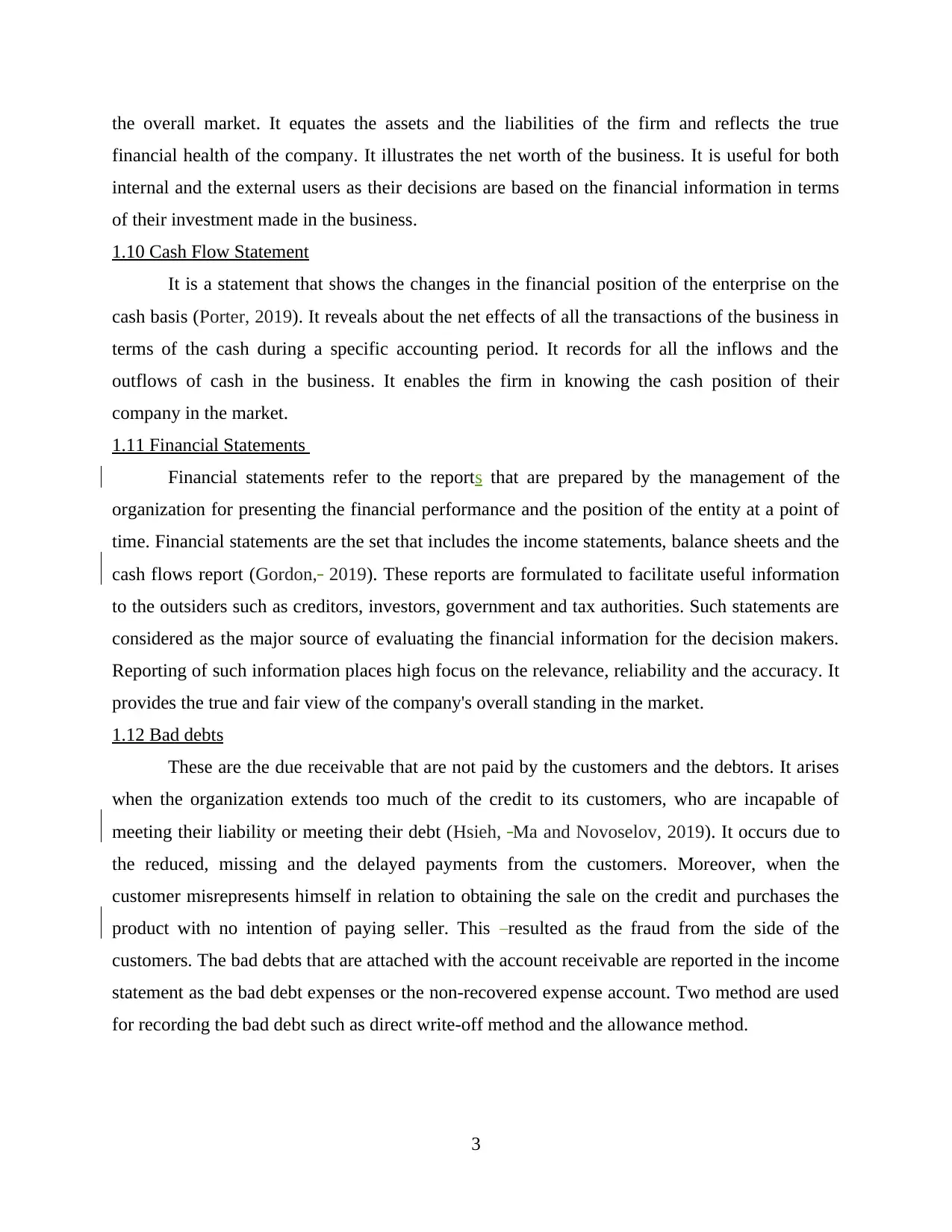
the overall market. It equates the assets and the liabilities of the firm and reflects the true
financial health of the company. It illustrates the net worth of the business. It is useful for both
internal and the external users as their decisions are based on the financial information in terms
of their investment made in the business.
1.10 Cash Flow Statement
It is a statement that shows the changes in the financial position of the enterprise on the
cash basis (Porter, 2019). It reveals about the net effects of all the transactions of the business in
terms of the cash during a specific accounting period. It records for all the inflows and the
outflows of cash in the business. It enables the firm in knowing the cash position of their
company in the market.
1.11 Financial Statements
Financial statements refer to the reports that are prepared by the management of the
organization for presenting the financial performance and the position of the entity at a point of
time. Financial statements are the set that includes the income statements, balance sheets and the
cash flows report (Gordon, 2019). These reports are formulated to facilitate useful information
to the outsiders such as creditors, investors, government and tax authorities. Such statements are
considered as the major source of evaluating the financial information for the decision makers.
Reporting of such information places high focus on the relevance, reliability and the accuracy. It
provides the true and fair view of the company's overall standing in the market.
1.12 Bad debts
These are the due receivable that are not paid by the customers and the debtors. It arises
when the organization extends too much of the credit to its customers, who are incapable of
meeting their liability or meeting their debt (Hsieh, Ma and Novoselov, 2019). It occurs due to
the reduced, missing and the delayed payments from the customers. Moreover, when the
customer misrepresents himself in relation to obtaining the sale on the credit and purchases the
product with no intention of paying seller. This resulted as the fraud from the side of the
customers. The bad debts that are attached with the account receivable are reported in the income
statement as the bad debt expenses or the non-recovered expense account. Two method are used
for recording the bad debt such as direct write-off method and the allowance method.
3
financial health of the company. It illustrates the net worth of the business. It is useful for both
internal and the external users as their decisions are based on the financial information in terms
of their investment made in the business.
1.10 Cash Flow Statement
It is a statement that shows the changes in the financial position of the enterprise on the
cash basis (Porter, 2019). It reveals about the net effects of all the transactions of the business in
terms of the cash during a specific accounting period. It records for all the inflows and the
outflows of cash in the business. It enables the firm in knowing the cash position of their
company in the market.
1.11 Financial Statements
Financial statements refer to the reports that are prepared by the management of the
organization for presenting the financial performance and the position of the entity at a point of
time. Financial statements are the set that includes the income statements, balance sheets and the
cash flows report (Gordon, 2019). These reports are formulated to facilitate useful information
to the outsiders such as creditors, investors, government and tax authorities. Such statements are
considered as the major source of evaluating the financial information for the decision makers.
Reporting of such information places high focus on the relevance, reliability and the accuracy. It
provides the true and fair view of the company's overall standing in the market.
1.12 Bad debts
These are the due receivable that are not paid by the customers and the debtors. It arises
when the organization extends too much of the credit to its customers, who are incapable of
meeting their liability or meeting their debt (Hsieh, Ma and Novoselov, 2019). It occurs due to
the reduced, missing and the delayed payments from the customers. Moreover, when the
customer misrepresents himself in relation to obtaining the sale on the credit and purchases the
product with no intention of paying seller. This resulted as the fraud from the side of the
customers. The bad debts that are attached with the account receivable are reported in the income
statement as the bad debt expenses or the non-recovered expense account. Two method are used
for recording the bad debt such as direct write-off method and the allowance method.
3
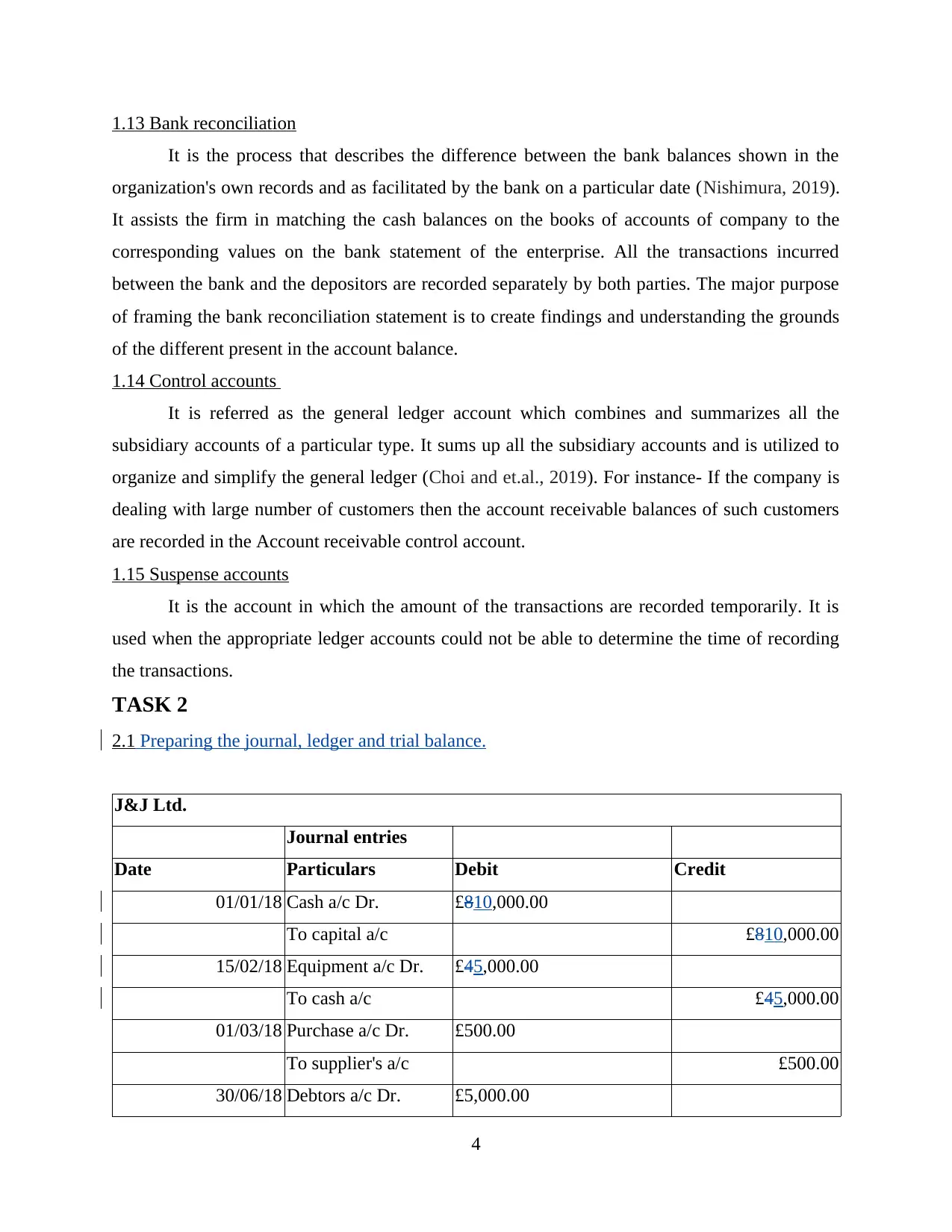
1.13 Bank reconciliation
It is the process that describes the difference between the bank balances shown in the
organization's own records and as facilitated by the bank on a particular date (Nishimura, 2019).
It assists the firm in matching the cash balances on the books of accounts of company to the
corresponding values on the bank statement of the enterprise. All the transactions incurred
between the bank and the depositors are recorded separately by both parties. The major purpose
of framing the bank reconciliation statement is to create findings and understanding the grounds
of the different present in the account balance.
1.14 Control accounts
It is referred as the general ledger account which combines and summarizes all the
subsidiary accounts of a particular type. It sums up all the subsidiary accounts and is utilized to
organize and simplify the general ledger (Choi and et.al., 2019). For instance- If the company is
dealing with large number of customers then the account receivable balances of such customers
are recorded in the Account receivable control account.
1.15 Suspense accounts
It is the account in which the amount of the transactions are recorded temporarily. It is
used when the appropriate ledger accounts could not be able to determine the time of recording
the transactions.
TASK 2
2.1 Preparing the journal, ledger and trial balance.
J&J Ltd.
Journal entries
Date Particulars Debit Credit
01/01/18 Cash a/c Dr. £810,000.00
To capital a/c £810,000.00
15/02/18 Equipment a/c Dr. £45,000.00
To cash a/c £45,000.00
01/03/18 Purchase a/c Dr. £500.00
To supplier's a/c £500.00
30/06/18 Debtors a/c Dr. £5,000.00
4
It is the process that describes the difference between the bank balances shown in the
organization's own records and as facilitated by the bank on a particular date (Nishimura, 2019).
It assists the firm in matching the cash balances on the books of accounts of company to the
corresponding values on the bank statement of the enterprise. All the transactions incurred
between the bank and the depositors are recorded separately by both parties. The major purpose
of framing the bank reconciliation statement is to create findings and understanding the grounds
of the different present in the account balance.
1.14 Control accounts
It is referred as the general ledger account which combines and summarizes all the
subsidiary accounts of a particular type. It sums up all the subsidiary accounts and is utilized to
organize and simplify the general ledger (Choi and et.al., 2019). For instance- If the company is
dealing with large number of customers then the account receivable balances of such customers
are recorded in the Account receivable control account.
1.15 Suspense accounts
It is the account in which the amount of the transactions are recorded temporarily. It is
used when the appropriate ledger accounts could not be able to determine the time of recording
the transactions.
TASK 2
2.1 Preparing the journal, ledger and trial balance.
J&J Ltd.
Journal entries
Date Particulars Debit Credit
01/01/18 Cash a/c Dr. £810,000.00
To capital a/c £810,000.00
15/02/18 Equipment a/c Dr. £45,000.00
To cash a/c £45,000.00
01/03/18 Purchase a/c Dr. £500.00
To supplier's a/c £500.00
30/06/18 Debtors a/c Dr. £5,000.00
4
⊘ This is a preview!⊘
Do you want full access?
Subscribe today to unlock all pages.

Trusted by 1+ million students worldwide
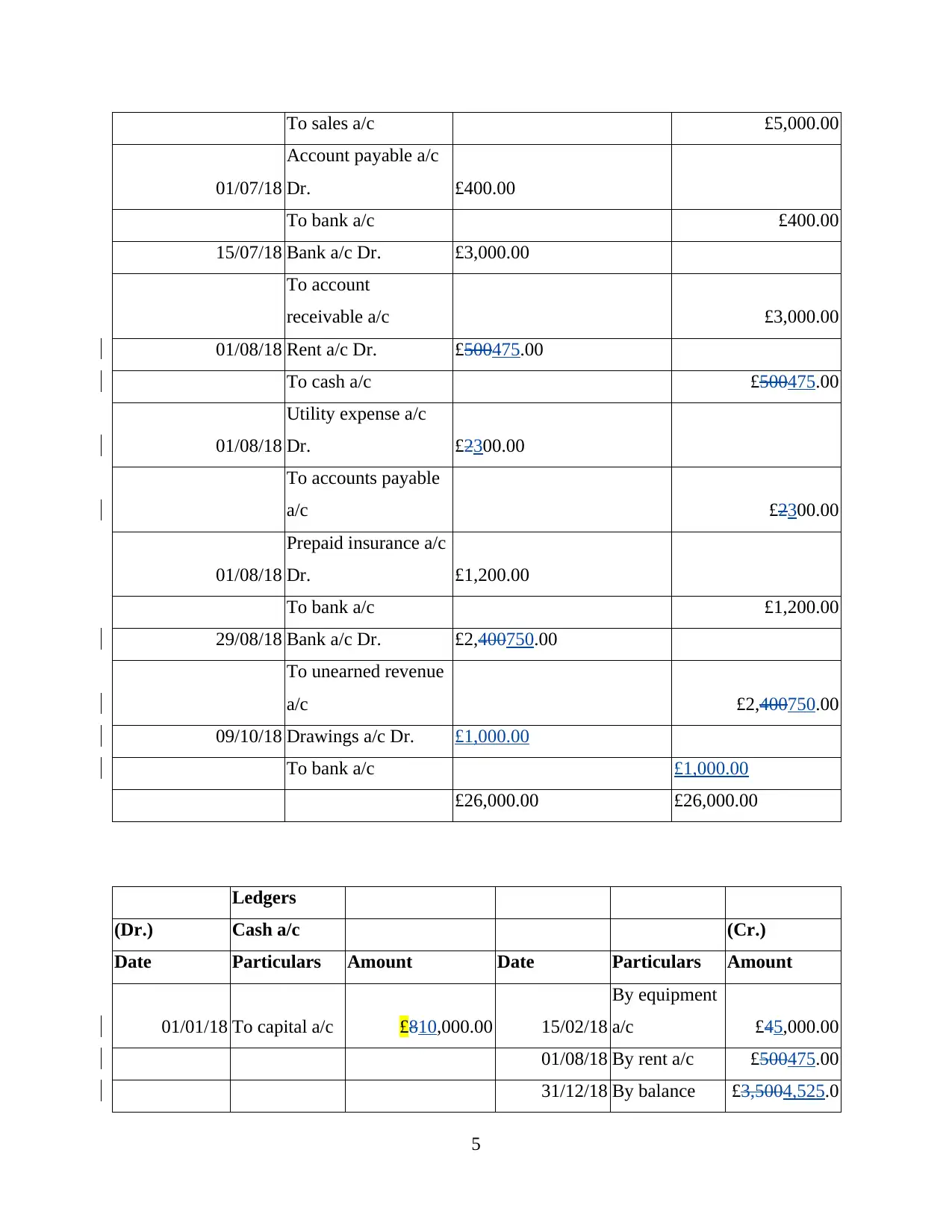
To sales a/c £5,000.00
01/07/18
Account payable a/c
Dr. £400.00
To bank a/c £400.00
15/07/18 Bank a/c Dr. £3,000.00
To account
receivable a/c £3,000.00
01/08/18 Rent a/c Dr. £500475.00
To cash a/c £500475.00
01/08/18
Utility expense a/c
Dr. £2300.00
To accounts payable
a/c £2300.00
01/08/18
Prepaid insurance a/c
Dr. £1,200.00
To bank a/c £1,200.00
29/08/18 Bank a/c Dr. £2,400750.00
To unearned revenue
a/c £2,400750.00
09/10/18 Drawings a/c Dr. £1,000.00
To bank a/c £1,000.00
£26,000.00 £26,000.00
Ledgers
(Dr.) Cash a/c (Cr.)
Date Particulars Amount Date Particulars Amount
01/01/18 To capital a/c £810,000.00 15/02/18
By equipment
a/c £45,000.00
01/08/18 By rent a/c £500475.00
31/12/18 By balance £3,5004,525.0
5
01/07/18
Account payable a/c
Dr. £400.00
To bank a/c £400.00
15/07/18 Bank a/c Dr. £3,000.00
To account
receivable a/c £3,000.00
01/08/18 Rent a/c Dr. £500475.00
To cash a/c £500475.00
01/08/18
Utility expense a/c
Dr. £2300.00
To accounts payable
a/c £2300.00
01/08/18
Prepaid insurance a/c
Dr. £1,200.00
To bank a/c £1,200.00
29/08/18 Bank a/c Dr. £2,400750.00
To unearned revenue
a/c £2,400750.00
09/10/18 Drawings a/c Dr. £1,000.00
To bank a/c £1,000.00
£26,000.00 £26,000.00
Ledgers
(Dr.) Cash a/c (Cr.)
Date Particulars Amount Date Particulars Amount
01/01/18 To capital a/c £810,000.00 15/02/18
By equipment
a/c £45,000.00
01/08/18 By rent a/c £500475.00
31/12/18 By balance £3,5004,525.0
5
Paraphrase This Document
Need a fresh take? Get an instant paraphrase of this document with our AI Paraphraser
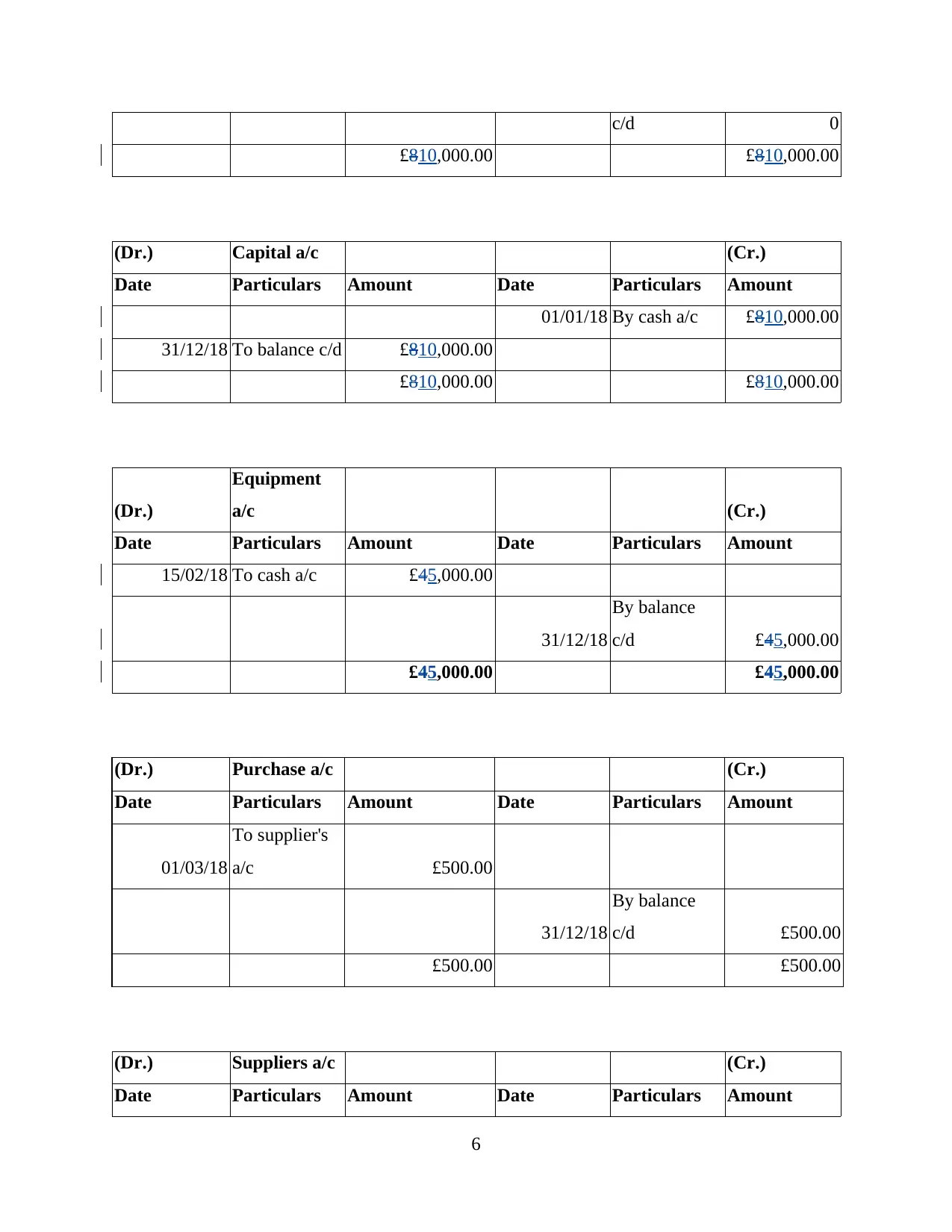
c/d 0
£810,000.00 £810,000.00
(Dr.) Capital a/c (Cr.)
Date Particulars Amount Date Particulars Amount
01/01/18 By cash a/c £810,000.00
31/12/18 To balance c/d £810,000.00
£810,000.00 £810,000.00
(Dr.)
Equipment
a/c (Cr.)
Date Particulars Amount Date Particulars Amount
15/02/18 To cash a/c £45,000.00
31/12/18
By balance
c/d £45,000.00
£45,000.00 £45,000.00
(Dr.) Purchase a/c (Cr.)
Date Particulars Amount Date Particulars Amount
01/03/18
To supplier's
a/c £500.00
31/12/18
By balance
c/d £500.00
£500.00 £500.00
(Dr.) Suppliers a/c (Cr.)
Date Particulars Amount Date Particulars Amount
6
£810,000.00 £810,000.00
(Dr.) Capital a/c (Cr.)
Date Particulars Amount Date Particulars Amount
01/01/18 By cash a/c £810,000.00
31/12/18 To balance c/d £810,000.00
£810,000.00 £810,000.00
(Dr.)
Equipment
a/c (Cr.)
Date Particulars Amount Date Particulars Amount
15/02/18 To cash a/c £45,000.00
31/12/18
By balance
c/d £45,000.00
£45,000.00 £45,000.00
(Dr.) Purchase a/c (Cr.)
Date Particulars Amount Date Particulars Amount
01/03/18
To supplier's
a/c £500.00
31/12/18
By balance
c/d £500.00
£500.00 £500.00
(Dr.) Suppliers a/c (Cr.)
Date Particulars Amount Date Particulars Amount
6
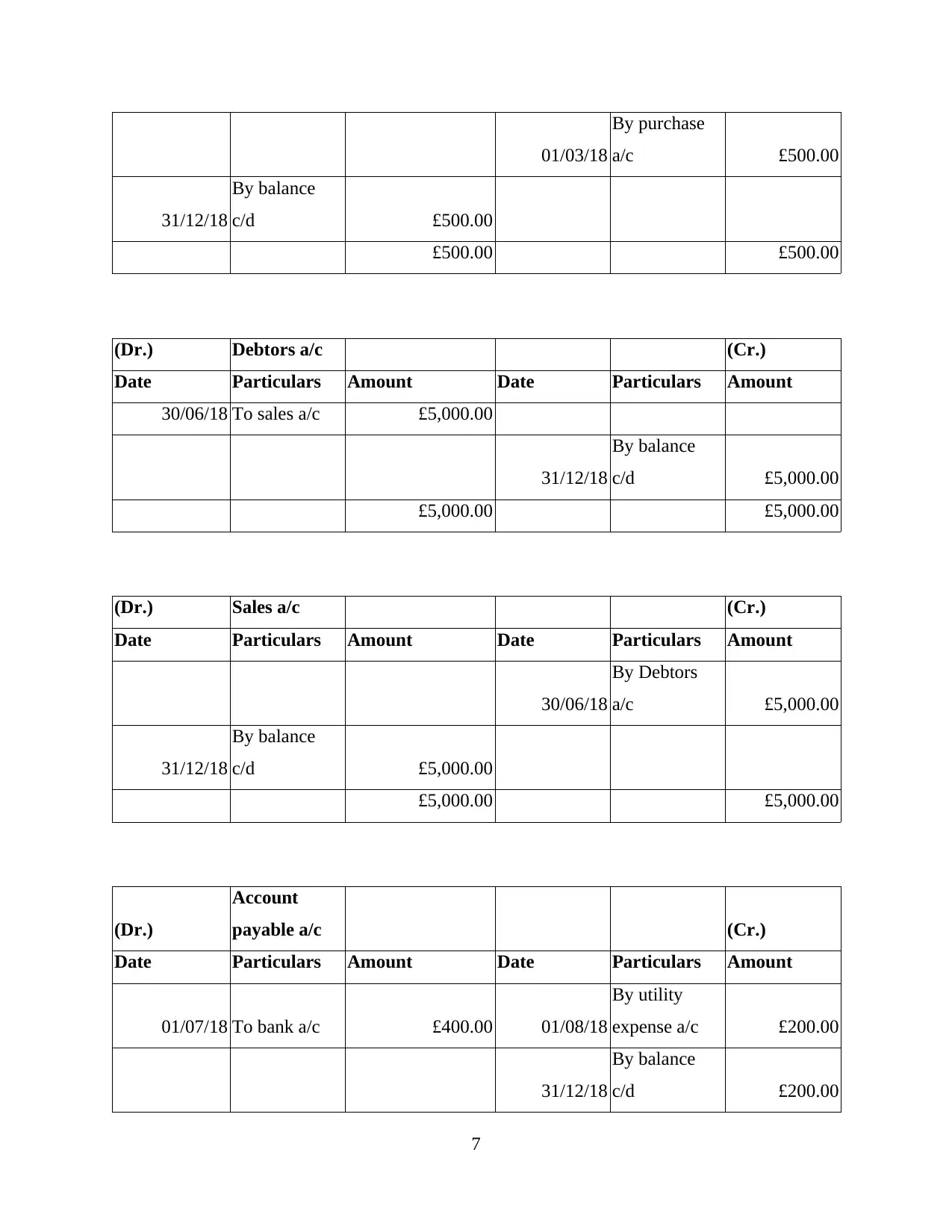
01/03/18
By purchase
a/c £500.00
31/12/18
By balance
c/d £500.00
£500.00 £500.00
(Dr.) Debtors a/c (Cr.)
Date Particulars Amount Date Particulars Amount
30/06/18 To sales a/c £5,000.00
31/12/18
By balance
c/d £5,000.00
£5,000.00 £5,000.00
(Dr.) Sales a/c (Cr.)
Date Particulars Amount Date Particulars Amount
30/06/18
By Debtors
a/c £5,000.00
31/12/18
By balance
c/d £5,000.00
£5,000.00 £5,000.00
(Dr.)
Account
payable a/c (Cr.)
Date Particulars Amount Date Particulars Amount
01/07/18 To bank a/c £400.00 01/08/18
By utility
expense a/c £200.00
31/12/18
By balance
c/d £200.00
7
By purchase
a/c £500.00
31/12/18
By balance
c/d £500.00
£500.00 £500.00
(Dr.) Debtors a/c (Cr.)
Date Particulars Amount Date Particulars Amount
30/06/18 To sales a/c £5,000.00
31/12/18
By balance
c/d £5,000.00
£5,000.00 £5,000.00
(Dr.) Sales a/c (Cr.)
Date Particulars Amount Date Particulars Amount
30/06/18
By Debtors
a/c £5,000.00
31/12/18
By balance
c/d £5,000.00
£5,000.00 £5,000.00
(Dr.)
Account
payable a/c (Cr.)
Date Particulars Amount Date Particulars Amount
01/07/18 To bank a/c £400.00 01/08/18
By utility
expense a/c £200.00
31/12/18
By balance
c/d £200.00
7
⊘ This is a preview!⊘
Do you want full access?
Subscribe today to unlock all pages.

Trusted by 1+ million students worldwide
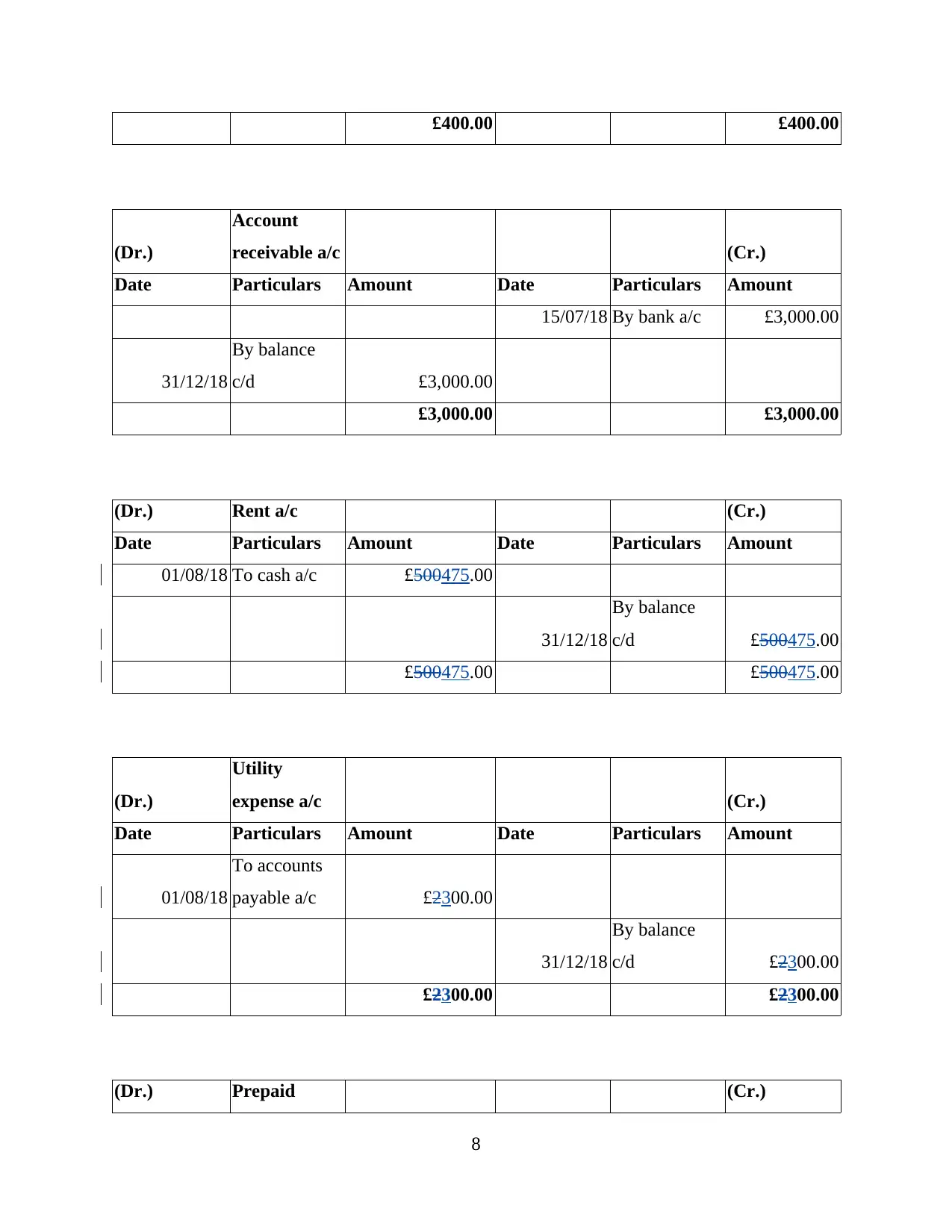
£400.00 £400.00
(Dr.)
Account
receivable a/c (Cr.)
Date Particulars Amount Date Particulars Amount
15/07/18 By bank a/c £3,000.00
31/12/18
By balance
c/d £3,000.00
£3,000.00 £3,000.00
(Dr.) Rent a/c (Cr.)
Date Particulars Amount Date Particulars Amount
01/08/18 To cash a/c £500475.00
31/12/18
By balance
c/d £500475.00
£500475.00 £500475.00
(Dr.)
Utility
expense a/c (Cr.)
Date Particulars Amount Date Particulars Amount
01/08/18
To accounts
payable a/c £2300.00
31/12/18
By balance
c/d £2300.00
£2300.00 £2300.00
(Dr.) Prepaid (Cr.)
8
(Dr.)
Account
receivable a/c (Cr.)
Date Particulars Amount Date Particulars Amount
15/07/18 By bank a/c £3,000.00
31/12/18
By balance
c/d £3,000.00
£3,000.00 £3,000.00
(Dr.) Rent a/c (Cr.)
Date Particulars Amount Date Particulars Amount
01/08/18 To cash a/c £500475.00
31/12/18
By balance
c/d £500475.00
£500475.00 £500475.00
(Dr.)
Utility
expense a/c (Cr.)
Date Particulars Amount Date Particulars Amount
01/08/18
To accounts
payable a/c £2300.00
31/12/18
By balance
c/d £2300.00
£2300.00 £2300.00
(Dr.) Prepaid (Cr.)
8
Paraphrase This Document
Need a fresh take? Get an instant paraphrase of this document with our AI Paraphraser
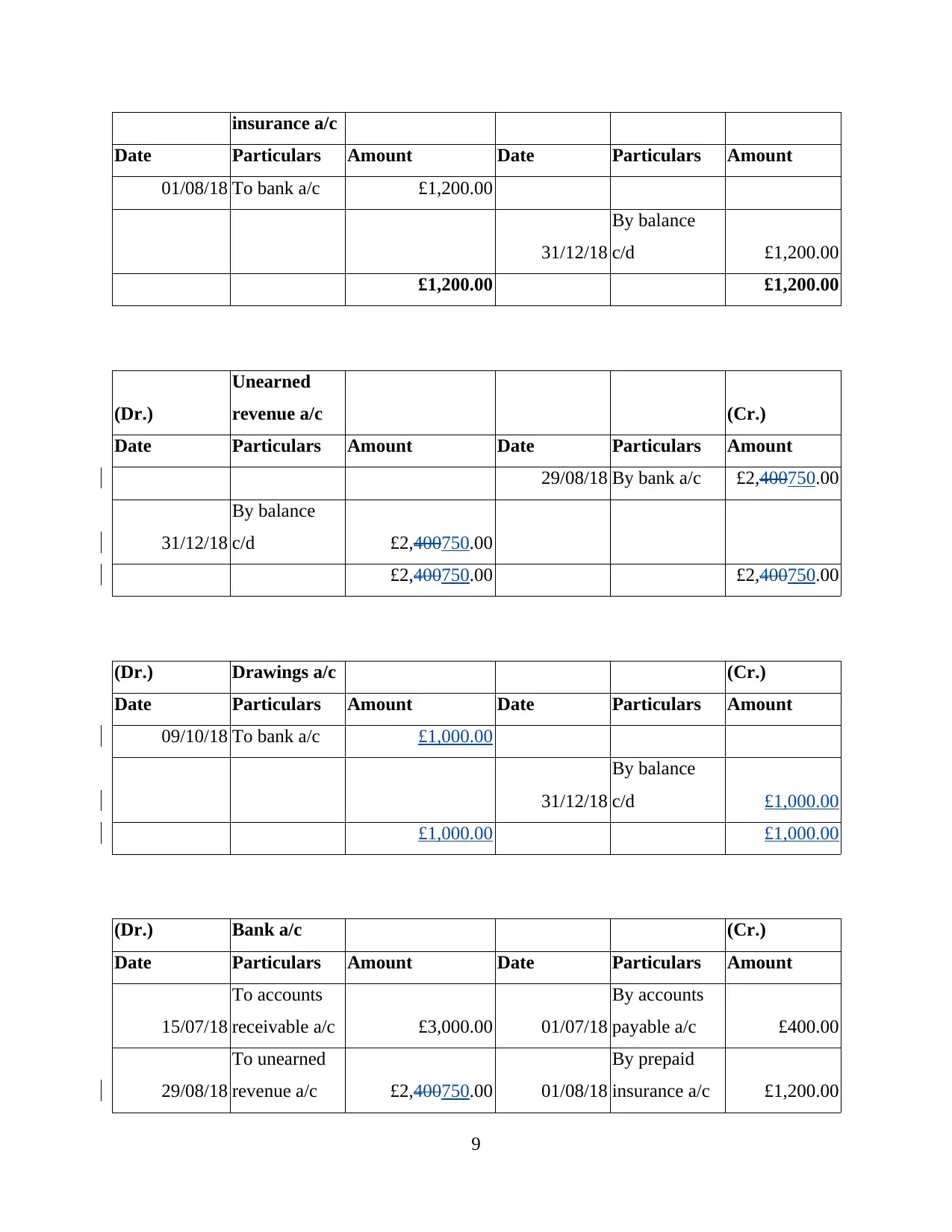
insurance a/c
Date Particulars Amount Date Particulars Amount
01/08/18 To bank a/c £1,200.00
31/12/18
By balance
c/d £1,200.00
£1,200.00 £1,200.00
(Dr.)
Unearned
revenue a/c (Cr.)
Date Particulars Amount Date Particulars Amount
29/08/18 By bank a/c £2,400750.00
31/12/18
By balance
c/d £2,400750.00
£2,400750.00 £2,400750.00
(Dr.) Drawings a/c (Cr.)
Date Particulars Amount Date Particulars Amount
09/10/18 To bank a/c £1,000.00
31/12/18
By balance
c/d £1,000.00
£1,000.00 £1,000.00
(Dr.) Bank a/c (Cr.)
Date Particulars Amount Date Particulars Amount
15/07/18
To accounts
receivable a/c £3,000.00 01/07/18
By accounts
payable a/c £400.00
29/08/18
To unearned
revenue a/c £2,400750.00 01/08/18
By prepaid
insurance a/c £1,200.00
9
Date Particulars Amount Date Particulars Amount
01/08/18 To bank a/c £1,200.00
31/12/18
By balance
c/d £1,200.00
£1,200.00 £1,200.00
(Dr.)
Unearned
revenue a/c (Cr.)
Date Particulars Amount Date Particulars Amount
29/08/18 By bank a/c £2,400750.00
31/12/18
By balance
c/d £2,400750.00
£2,400750.00 £2,400750.00
(Dr.) Drawings a/c (Cr.)
Date Particulars Amount Date Particulars Amount
09/10/18 To bank a/c £1,000.00
31/12/18
By balance
c/d £1,000.00
£1,000.00 £1,000.00
(Dr.) Bank a/c (Cr.)
Date Particulars Amount Date Particulars Amount
15/07/18
To accounts
receivable a/c £3,000.00 01/07/18
By accounts
payable a/c £400.00
29/08/18
To unearned
revenue a/c £2,400750.00 01/08/18
By prepaid
insurance a/c £1,200.00
9
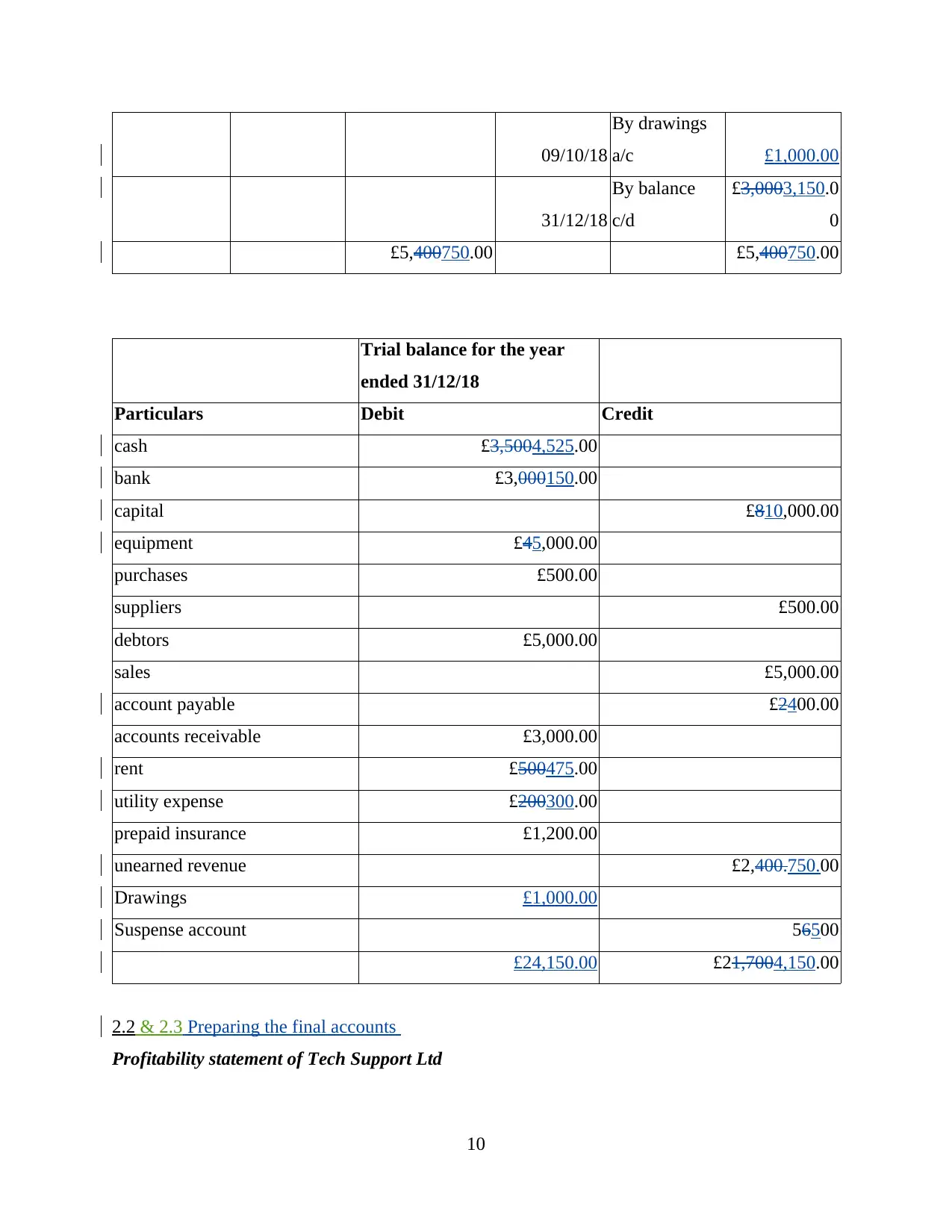
09/10/18
By drawings
a/c £1,000.00
31/12/18
By balance
c/d
£3,0003,150.0
0
£5,400750.00 £5,400750.00
Trial balance for the year
ended 31/12/18
Particulars Debit Credit
cash £3,5004,525.00
bank £3,000150.00
capital £810,000.00
equipment £45,000.00
purchases £500.00
suppliers £500.00
debtors £5,000.00
sales £5,000.00
account payable £2400.00
accounts receivable £3,000.00
rent £500475.00
utility expense £200300.00
prepaid insurance £1,200.00
unearned revenue £2,400.750.00
Drawings £1,000.00
Suspense account 56500
£24,150.00 £21,7004,150.00
2.2 & 2.3 Preparing the final accounts
Profitability statement of Tech Support Ltd
10
By drawings
a/c £1,000.00
31/12/18
By balance
c/d
£3,0003,150.0
0
£5,400750.00 £5,400750.00
Trial balance for the year
ended 31/12/18
Particulars Debit Credit
cash £3,5004,525.00
bank £3,000150.00
capital £810,000.00
equipment £45,000.00
purchases £500.00
suppliers £500.00
debtors £5,000.00
sales £5,000.00
account payable £2400.00
accounts receivable £3,000.00
rent £500475.00
utility expense £200300.00
prepaid insurance £1,200.00
unearned revenue £2,400.750.00
Drawings £1,000.00
Suspense account 56500
£24,150.00 £21,7004,150.00
2.2 & 2.3 Preparing the final accounts
Profitability statement of Tech Support Ltd
10
⊘ This is a preview!⊘
Do you want full access?
Subscribe today to unlock all pages.

Trusted by 1+ million students worldwide
1 out of 21
Related Documents
Your All-in-One AI-Powered Toolkit for Academic Success.
+13062052269
info@desklib.com
Available 24*7 on WhatsApp / Email
![[object Object]](/_next/static/media/star-bottom.7253800d.svg)
Unlock your academic potential
Copyright © 2020–2025 A2Z Services. All Rights Reserved. Developed and managed by ZUCOL.





